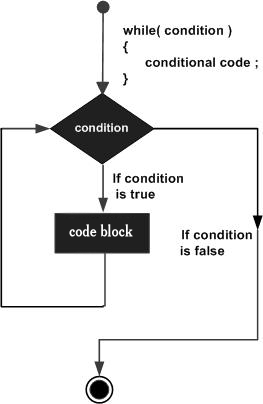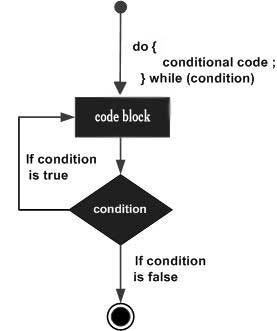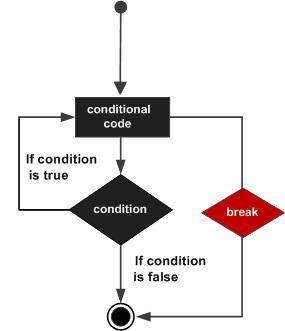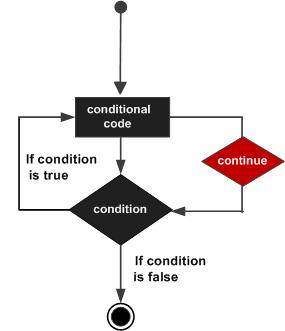#include <stdio.h> main() { printf( "Hello, World!\n"); printf( "Hello, World!\n"); printf( "Hello, World!\n"); printf( "Hello, World!\n"); printf( "Hello, World!\n"); }When above program is executed, it produces the following result:
Hello, World! Hello, World! Hello, World! Hello, World! Hello, World!It was simple, but again let's consider another situation when you want to write Hello, World! thousand times, what you will do in such situation? Are we going to write printf() statement thousand times? No, not at all. Almost all the programming languages provide a concept called loop, which helps in executing one or more statements up to desired number of times. All high-level programming languages provide various forms of loops, which can be used to execute one or more statements repeatedly.
Let's write above C program with the help of a while loop and later we will discuss how does this loop work:
#include <stdio.h> main() { int i = 0; while ( i < 5 ) { printf( "Hello, World!\n"); i = i + 1; } }When above program is executed, it produces the following result:
Hello, World! Hello, World! Hello, World! Hello, World! Hello, World!Above program makes use of while loop, which is being used to execute a set of programming statements enclosed within {....}. Here, computer first checks whether given condition, i.e., variable "a" is less than 5 or not and if it finds condition is true then the loop body is entered to execute given statements. Here, we have the following two statements in the loop body:
- First statement is printf() function, which prints Hello World!
- Second statement is i = i + 1, which is used to increase the value of variable i
To conclude, a loop statement allows us to execute a statement or group of statements multiple times and following is the general form of a loop statement in most of the programming languages:
 This tutorial has been designed to present programming's basic
concepts to non-programmers, so let's discuss about two important loops
available in C programming language. Once you are clear about these two
loops, then you can pickup C programming tutorial or a reference book
and check what are other loops available in C and how do they work.
This tutorial has been designed to present programming's basic
concepts to non-programmers, so let's discuss about two important loops
available in C programming language. Once you are clear about these two
loops, then you can pickup C programming tutorial or a reference book
and check what are other loops available in C and how do they work.The while Loop
A while loop available in C Programming language has following syntax:while ( condition ) { /*....while loop body ....*/ }Above code can be represented in the form of a flow diagram as shown below:
 There are following important points to note about a while loop:
There are following important points to note about a while loop:- A while loop starts with a keyword while followed by a condition enclosed in ( ).
- Further to while() statement you will have body of the loop enclosed in curly braces {...}.
- A while loop body can have one or more lines of source code to be executed repeatedly.
- If while loop body has just one line, then its optional to use curly braces {...}.
- A while loop keeps executing its body till given condition is true. As soon as condition becomes fast, while loop comes out and continue executing from immediate next statement after while loop body.
- A condition is usually a relational statement, which is evaluated to either true or false values. A value equal to zero is treated as false and any non-zero value works like a true for the condition.
The do...while Loop
If you have noted while loop, it checks given condition before it executes given statements of the code. C programming provides another form of loop, which is called do...while loop and allows to execute a loop body before checking given condition. This has following syntax:do { /*....do...while loop body ....*/ } while ( condition );Above code can be represented in the form of a flow diagram as shown below:
 If you will write above example using do...while loop, then Hello, World will produce the same result:
If you will write above example using do...while loop, then Hello, World will produce the same result:#include <stdio.h> main() { int i = 0; do { printf( "Hello, World!\n"); i = i + 1; }while ( i < 5 ); }When above program is executed, it produces the following result:
Hello, World! Hello, World! Hello, World! Hello, World! Hello, World!
The break statement
When the break statement is encountered inside a loop, the loop is immediately terminated and program control resumes at the next statement following the loop. The syntax for a break statement in C is as follows:break;A break statement can be represented in the form of a flow diagram as shown below:
 Following is a variant of the above program, but it will come out after printing Hello World! only three times:
Following is a variant of the above program, but it will come out after printing Hello World! only three times:#include <stdio.h> main() { int i = 0; do { printf( "Hello, World!\n"); i = i + 1; if( i == 3 ) { break; } }while ( i < 5 ); }When above program is executed, it produces the following result:
Hello, World! Hello, World! Hello, World!
The continue statement
The continue statement in C programming language works somewhat like the break statement. Instead of forcing termination, however, continue forces the next iteration of the loop to take place, skipping any code in between. The syntax for a continue statement in C is as follows:continue;A continue statement can be represented in the form of a flow diagram as shown below:
 Following is a variant of the above program but it will skip printing when variable has a value equal to 3:
Following is a variant of the above program but it will skip printing when variable has a value equal to 3:#include <stdio.h> main() { int i = 0; do { if( i == 3 ) { i = i + 1; continue; } printf( "Hello, World!\n"); i = i + 1; }while ( i < 5 ); }When above program is executed, it produces the following result:
Hello, World! Hello, World! Hello, World! Hello, World!
Loops in Java
Following is the equivalent program written in Java programming language. Java programming language also provides while and do...while loops. Following program will be used to print Hello, World! five times as we did in case of C Programming:You can try to execute following program to see the output, which must be identical to the result generated by the above example.
public class DemoJava { public static void main(String []args) { int i = 0; while ( i < 5 ) { System.out.println("Hello, World!"); i = i + 1; } } }The break and continue statements in Java programming work very similar way, what they work in C programming.
Loops in Python
Following is the equivalent program written in Python. Python also provides while and do...while loops. Following program will be used to print Hello, World! five times as we did in case of C Programming. Here you must note that Python programming does not make use of curly braces for loop body, instead it simply identifies the body of the loop using indentation of the statements.You can try to execute following program to see the output. To show the difference I used one more print statement, which will be executed when loop will be over.
i = 0 while (i < 5): print "Hello, World!" i = i + 1 print "Loop ends"When above program is executed, it produces the following result:
Hello, World! Hello, World! Hello, World! Hello, World! Hello, World! Loop endsThe break and continue statements in Python programming work very similar way as they work in C programming.
No comments:
Post a Comment